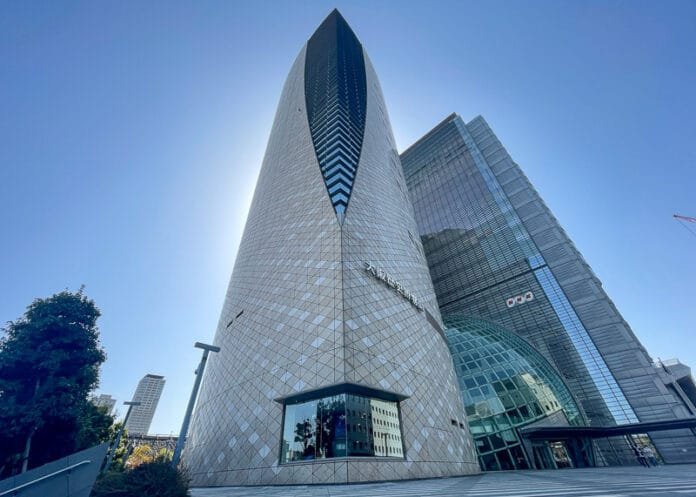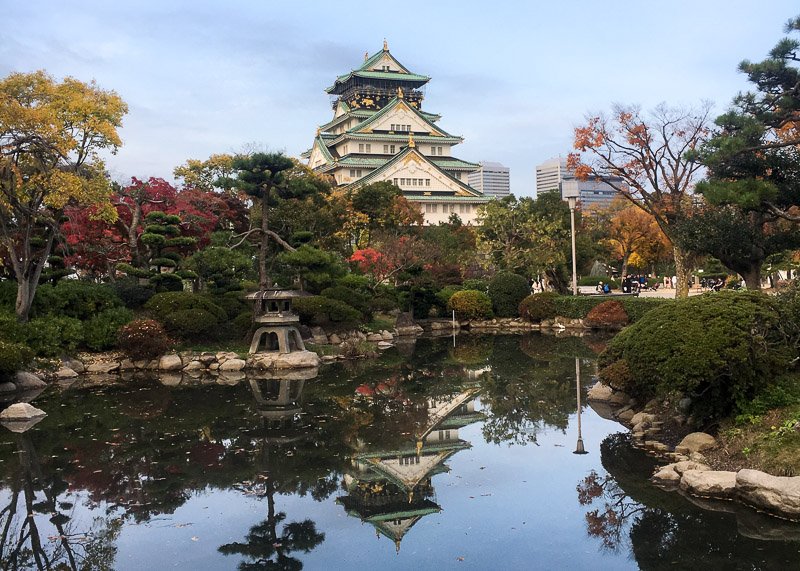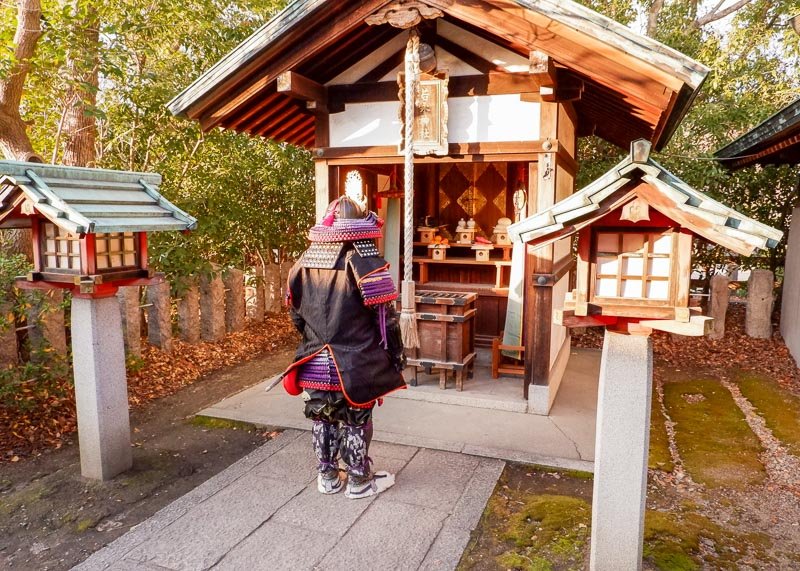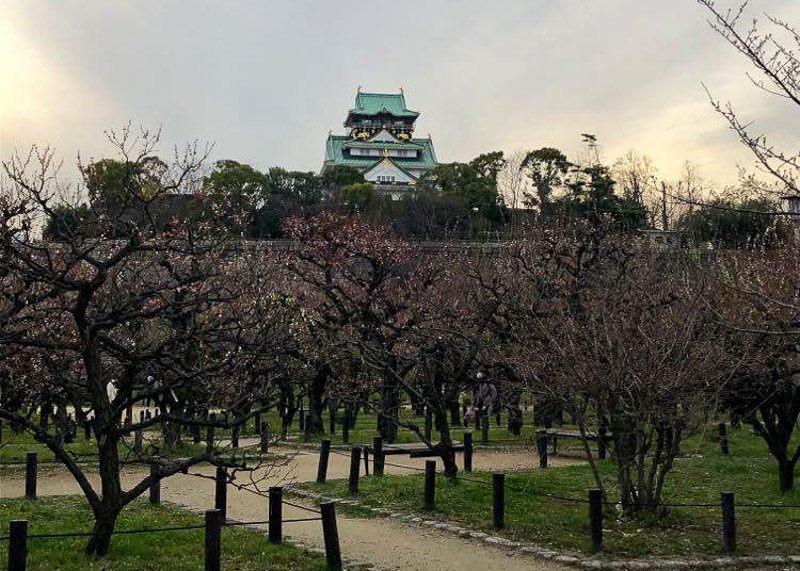
Osaka is home to many great museums where you can learn more about Japan and they can provide you shelter if a rainy day changes your plans. After showing you around the Osaka Museum of Housing and Living, now I would like to take you on a tour to the Osaka Museum of History that is conveniently located nearby the famous Osaka Castle.
Table of Contents
Introduction to the museum
Osaka Museum of History is an interactive museum that provides a truly comprehensive and thorough look into the history of Osaka in a very entertaining way. The museum is located in an unusual modernistic building that also serves as a NHK Broadcast Centre. The spaces of the museum are spread from the 7th to the 10th floor, and the views from here over the Osaka Castle and the park are alone worth the admission price.


Exhibits overview
After paying the admission in the foyer of the building, you will be shown to the elevators that will take you to the 10th floor, where the exhibitions start. From here you will make your way down while soaking in an impressive history of Osaka from ancient to modern times.
All exhibits are very interactive. Beside dioramas and historical artefacts showcased behind glass, you will also find here life-size streets with shops and mannequins dressed in costumes so you can directly see how Osaka was changing through time.
Osaka in the Ancient Period
On the 10th floor of the museum, we learn about Osaka in the 7th century. The city was dominated by the impressive Naniwa Palace whose remains can be directly seen from the windows of the museum. In the pictures underneath the windows, you can see, how the structure was built during the times of its biggest glory. The room features massive pillars and mannequins in traditional kimonos to enhance your experience of how the life inside the Naniwa Palace looked like in the past.


Naniwa Palace
Naniwa Palace was the first palace in Japan to be modelled after the palaces in China. It was built on a scale that was never seen before – with many rows of beautifully constructed buildings. Unfortunately, only after 40 year since the palace was finished, a fire broke out and burned down most of the buildings to the ground. It took another 40 years to rebuild the palace that we call today Latter Naniwa Palace and its exact reproduction (on a much smaller scale) can be seen in the museum today.
The Naniwa Palace was used from 652 AD until 784 AD and it is located in today’s Chuo Ward, right next to the Osaka Castle Park. Today, there’s not much left of the ruins that once used to be the most impressive palace of Japan, but you can still visit the site or chill in the park with vast greenery and trees that surround it.


Naniwa as an important port
Besides the impressive palace, ancient Naniwa was also an important arrival and departure port into the Seto Inland Sea. Amounts of good as well as people, were flowing into Naniwa not only from Wester Japan, but also from China and Korea.
Daily life in Osaka during ancient times
People from the villages nearby Naniwa also made great use of this marine transportation. Pottery, earthenware and other objects from distant places were found at this site, suggesting that the villages prospered well from the port. Many of the original ancient objects are on display along the walls on the 10th floor of the museum.
Religion and Temples during Naniwa period
Religious texts and images of Buddha were also brought to Japan via Naniwa Port. Buddhist priests and scholars landed here from China and Korea and new Buddhist temples, such as Shitenno-ji Temple, were built. Shitenno-ji Temple is the oldest officially administrated Buddhist temple in Japan that you can still visit today. As Buddhism was becoming more and more popular, a bustling town grew around Shitenno-ji that consisted of around seven thousand households. The diorama of this community can be seen in the museum.


Life in Osaka through Middles Ages to the early Modern Period
Descending down to the 9th floor of the Osaka Museum of History, we are also progressing in time to the Middle Ages and the early modern times, known as Edo Period (or also Tokugawa period). This storey features colorful life-sized displays showing off the everyday life in Osaka during this time.
New center of the city
Even though the Naniwa Palace was torn down, Osaka was culturally and economically thriving. The Shitenno-ji Temple has become the center of the city and new temples were popping up in nearby towns as well. In the 14th century, many wars and battles were ravaging Osaka, so at the end of the 15th century, another important temple was build – Hogan-ji Temple. The temple was built as a fortress to keep warlords away and it also served as the new city center.


Osaka Castle
Almost a century later, since Hogan-ji Temple was built, Japanese samurai and warlord Toyotomi Hideyoshi unified Japan and built Osaka Castle at the place of former Hogan-ji. He also started to expand and improve the surrounding town. Osaka’s convenient location was perfect for gathering products from all over Japan and thus the trade flourished. Craftsmen and merchants moved into the city, founding the base for the welfare that continues in Osaka to this day.
Everyday life in Osaka during Edo Period
Life of regular people in Osaka – that is what the museum is mostly focused on. Through miniatures and graphics you can very well imagine how the everyday life looked like. Edo period was characterized by economic growth, “no more wars” policy and enjoyment in arts and culture.
Nation’s Kitchen
In the displays we can see for example a vegetable market that served for the wholesale distribution of products from farms and villages surrounding Osaka, a traditional wooden boat used to sail through the many canals, or a miniature of a warehouse complex. Such warehouses played a major role in supporting Osaka’s economic activities. Around this time, in Edo Period, Osaka also got its famous nickname – The Nation’s Kitchen.


Culture of Townspeople
Life in Osaka was developing in a field of wealth, culture, entertainment, learning and art and all of these attributes were enjoyed by the townspeople. They were able to gather goods, as well as information, and this way they developed a unique culture that spread out from Osaka. Publishing books and printing illustrations was a thriving business in the city and because Osaka was far from the political center of Japan, people here were able to enjoy greater freedom to think and to engage with new activities.
Beginnings of Dotonbori as an entertainment district
Many forms of culture developed around the performing arts and on the 9th floor of the museum you can admire some historical masks and puppets used in shows to entertain people. Many Kabuki and Bunraku (puppets) theatres were built along the Dotonbori canal and surroundings area. The theatres in this district featured unique structures and ornamentation, for example they had a signboard with the program for the day. At that time, in Dotonbori there were six Kabuki and five Bunraku theatres.


Archaeological site
Descending further down to the 8th floor, we enter an area of the museum that used mostly for the enjoyment of every historical enthusiast – an archaeological site. It is a reconstruction of an archaeological dig with actual tools that are used to uncover the past. Here you can learn more about how the ruins of the Naniwa Palace were discovered and you can try and use some of the tools to find the fragments of historical objects in the sand.
Unfortunately, during our visit this area was closed due to the Covid-19 pandemic.


Osaka in the Modern Times
The whole 7th floor of the Osaka Museum of History is a large, life-scale reproduction of streets, shops and households in Osaka in the early 20th century. This is my favorite part of the museum, because it is lively, colorful, engaging and talks about recent events. Various household objects and photographs from the Showa Era uncover more about everyday life of Osakans during this time, while the artefacts from the WW II. reveal how the modern wars impacted the city and its inhabitants.


Age of Greater Osaka
As the 20th century approached, it became necessary to rebuild the old traditional townscape to something new and modern. Gradually, towns were expanded and residential areas were spread outwards to the suburbs. First metro line Midosuji started to operate between Kita district (Umeda station) and Shinsaibashi station. This period of time is known as the “Age of Greater Osaka” and that is what the museum recreates – visitors are able to walk through a cityscape, as it was back then at the beginning of 20th century.


Hoenzaka Warehouses
After you finish your tour through the museum, don’t forget to visit the reconstruction of the 5th century Hoenzaka warehouse that is located in front of the museum (as you go towards Tanimachiyonchome station). Sixteen of these elevated warehouses with thatched roofs were discovered by archaeologists in the area around former Naniwa Palace. The interior of this one is open to public, but be aware that the last admission is at 16:30 (30 minutes before the museum closing time).

Useful information before your visit
How to get there/closest station
Tanimachiyonchome is the closest station to the museum. The number 9 exit from the station will lead you directly to a small square in front of the entrance to the building. You can get to the station with green Chuo line or purple Tanimachi line (both are metro lines).
If you would like to take JR loop line, you can get off at the Morinomiya station which is located at the entrance to the Osaka Castle Park. From there it’s around 1 km walk to the museum. Alternatively, you can hop on Chuo line on Morinomiya station and ride one stop to the Tanimachiyonchome station.
Osaka Museum of History entrance fees
Adults – 600 yen
High school and university students – 400 yen
Elementary school students – free
Opening hours
Museum is open daily from 9:30 till 17:00, except of Tuesdays when it’s closed.


What to do in the Osaka Castle Park
The Osaka Museum of History is conveniently located right at the edge of Osaka Castle Park. Osaka Castle is an unmissable place to see when visiting this city so if you are looking for some options what to do around the park, here are few points for your inspiration. The park is so large that you can make a whole day out of it!
Visit Osaka Castle
Osaka Castle looks majestic from the outside, there’s no doubt about that, but did you know that you can actually visit also the interior of this magnificent building? You can experience how Japanese castles looked like in the past, which is very different from European castles, and even though there is not much inside in terms of furniture, from the top of the tower you can see beautiful views over the park and the city.
Go on a boat tour
The park surrounding the Osaka Castle is cut through with several moats. You can embark on a scenic cruise in a small golden boat around the park and the massive stone castle walls. If you are owner of the Osaka Amazing Pass, the boat ride should be included in the price of the pass.


Plum trees garden/Ume garden and arboretum
If you are visiting Osaka from mid-February till early March, don’t forget to check out the plum garden (ume in Japanese). The plum trees bloom earlier than sakura and they have lovely bright pink flowers with sweet scent. The garden is located behind the first moat on the east side of the castle (there are signs in English so you will not miss it).
Illusion museum
If you are travelling with kids, they will be surely interested in the fun Illusion Museum, located inside Miraiza building right in front of the castle on the main square. It’s one of the new entrainment spots in Osaka filled with magic, illusions and performances from all over the world.
The admission to the museum is 500 yen, children under 11 years old are admitted for free.
Osaka Castle Playground Equipment Square
Another great place for children is Osaka Castle Equipment Square where they can try different fun climbing frames and monkey bars. There is Starbucks, Lawson and vending machines nearby so parents can sit down, relax and enjoy the view on the castle.
Blue Birds Rooftop Terrace
Miraiza building is right next to Osaka Castle, and beside a souvenir shop and a couple of restaurants, it also features rooftop terrace. Come here for sunset and enjoy the best view over the most beautiful building in Osaka!
Hokoku shrine
Hokoku shrine is a small Shinto shrine in the Osaka Castle Park. It was built in the 1800s as an honor for the samurai and leader Toyotomi Hideyoshi who built the Osaka Castle. The shrine is very serene and it’s a popular place for Japanese couples to get married.
Nishinomaru Garden
Nishinomaru Garden is located behind the West Outer Moat of the Osaka Castle and it has undoubtedly the best views on the castle. It is a beautiful manicured garden with big lawn and many cherry blossom trees that bloom from the end of March till the beginning of April. Because of the great view and to keep the atmosphere in the garden quaint, you have to pay extra fee of 200 yen (350 yen during cherry blossom season) to go inside and it has opening hours from 9 am to 5 pm.
If you happen to be in Osaka during winter, you can visit the garden for amazing winter illuminations.



























[…] Du kan læse mere om Osaka Museum of History her. […]